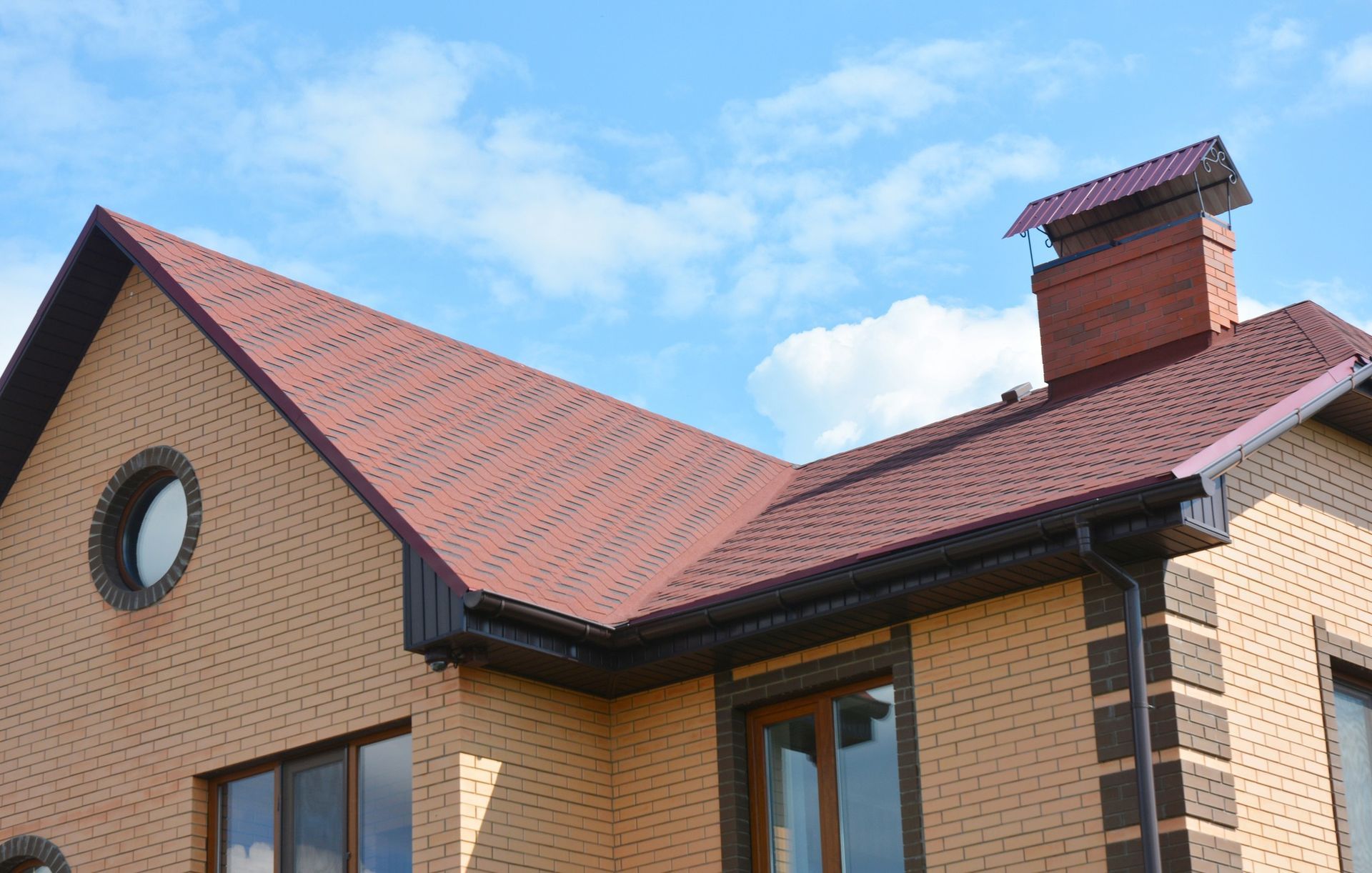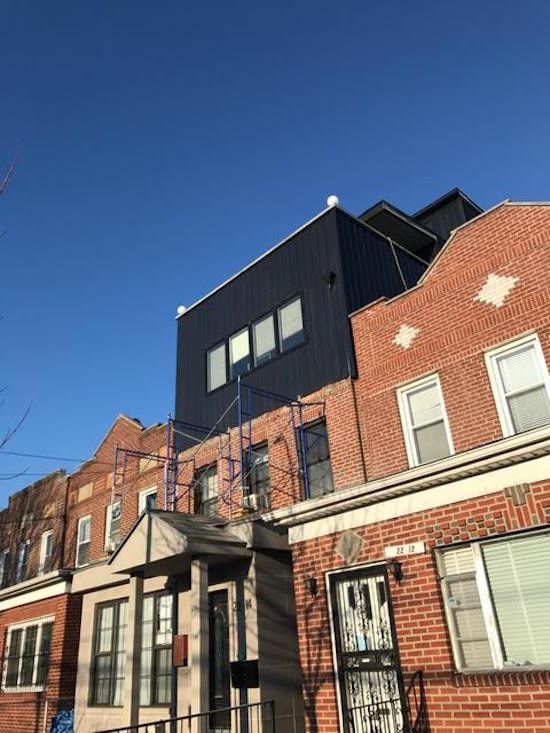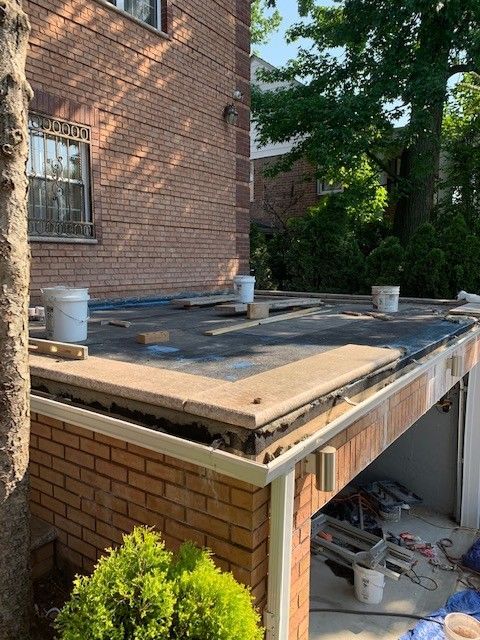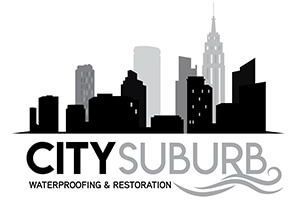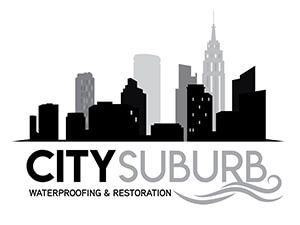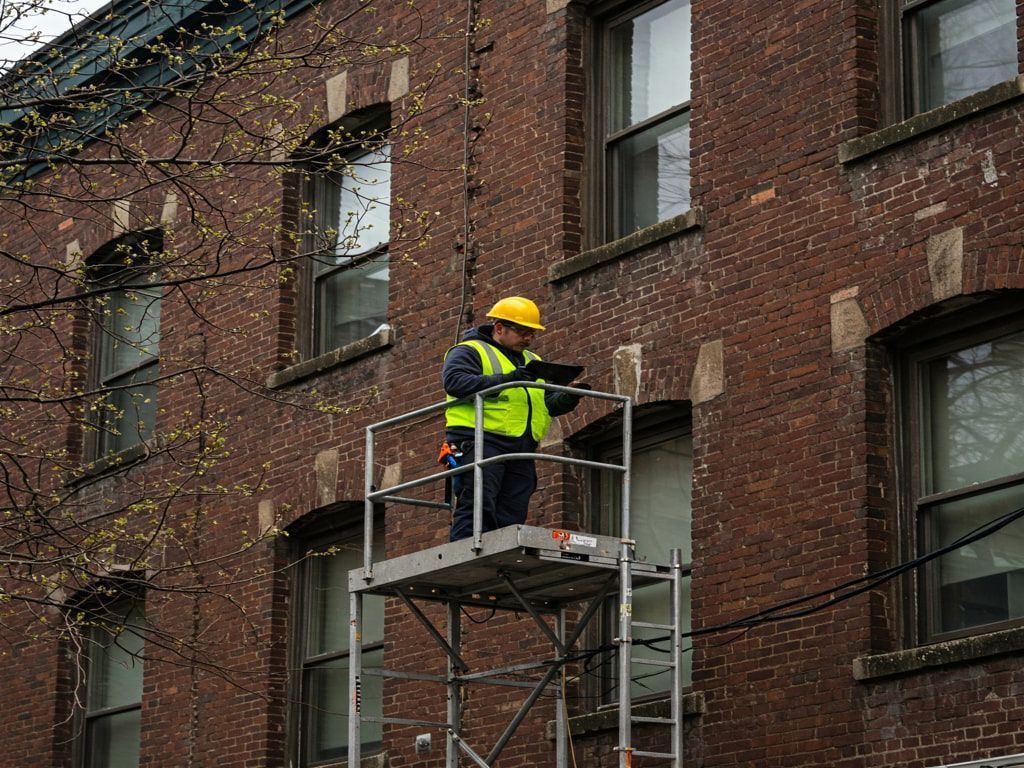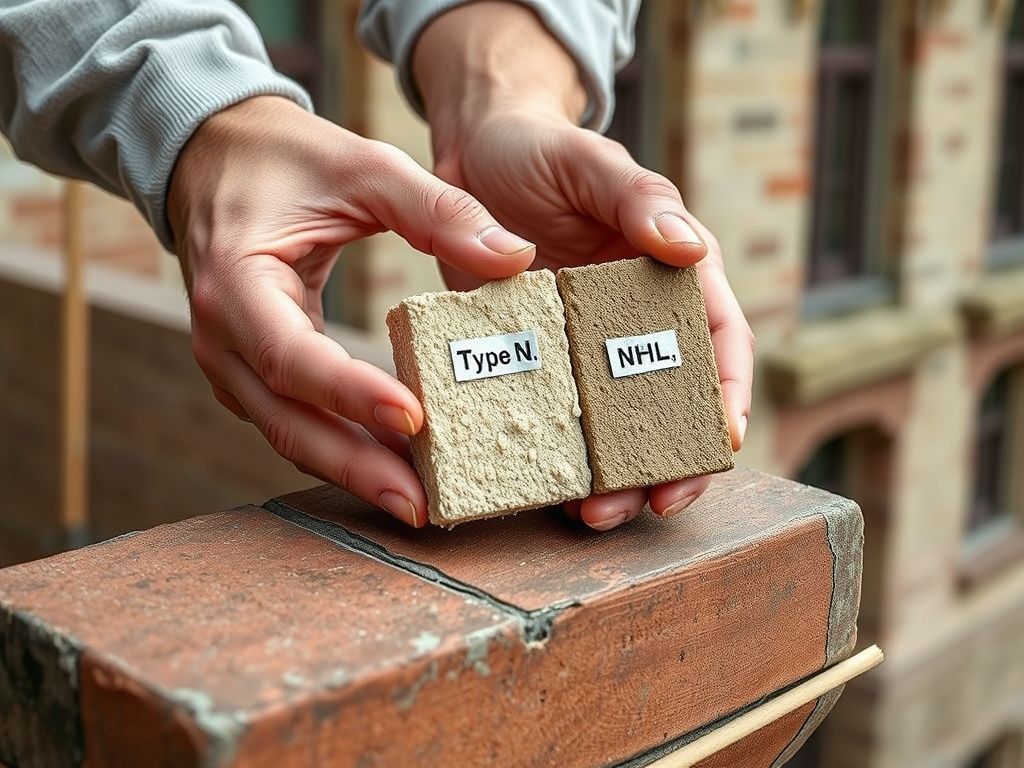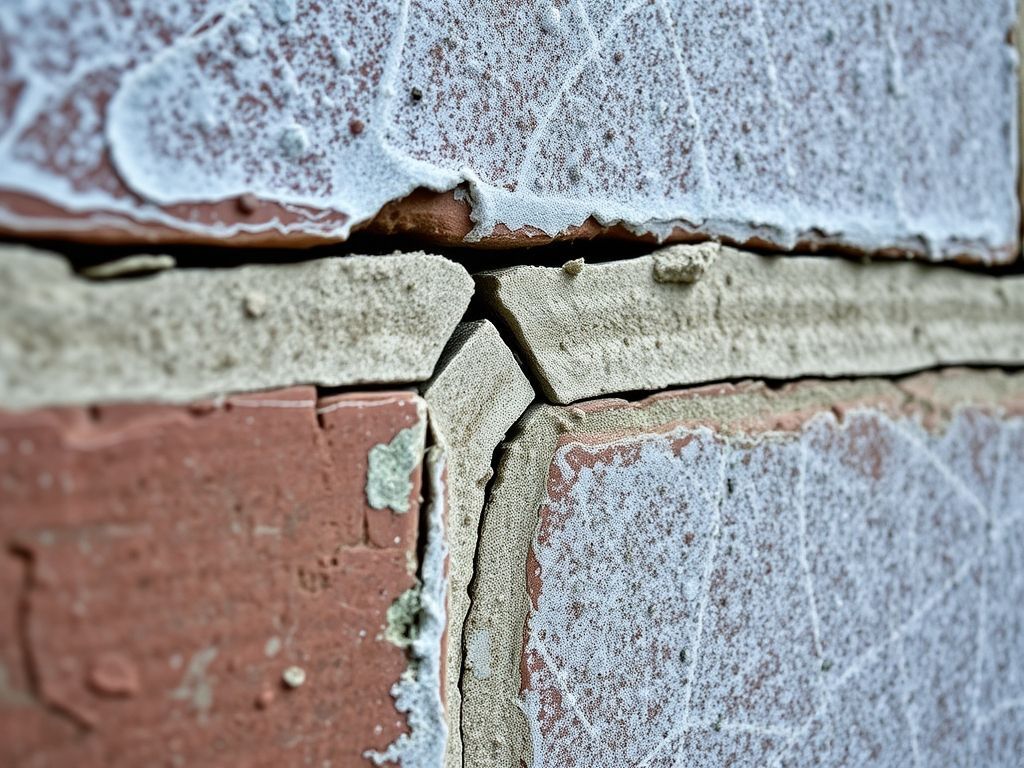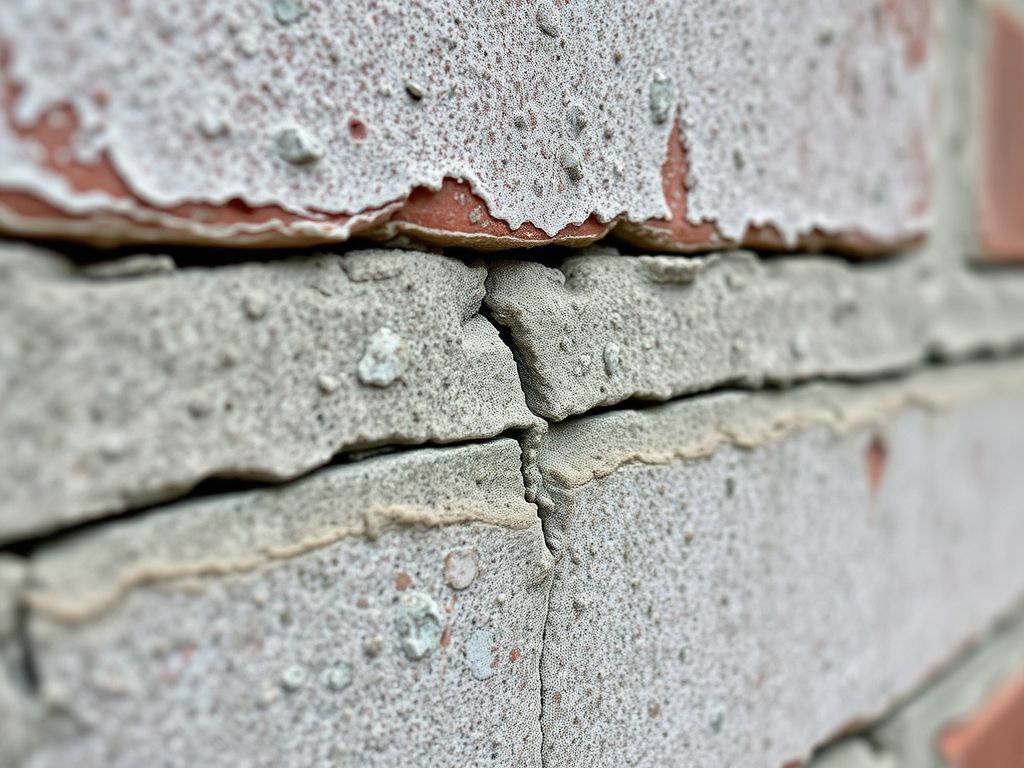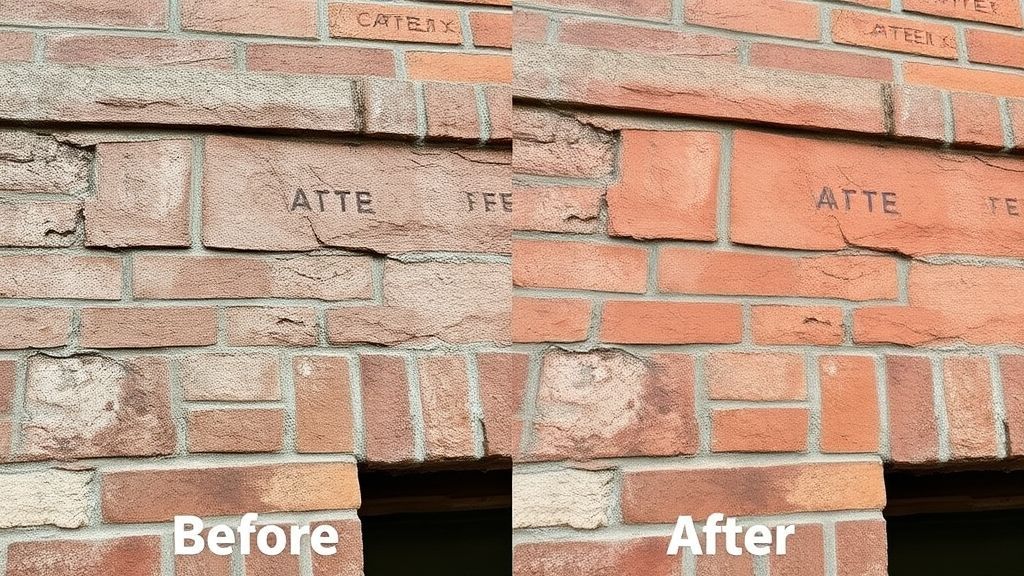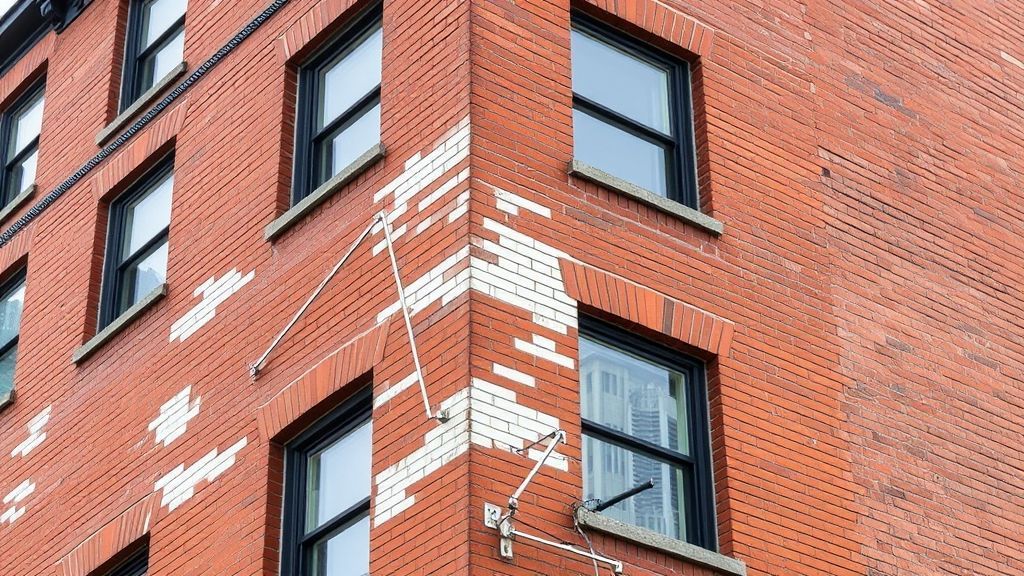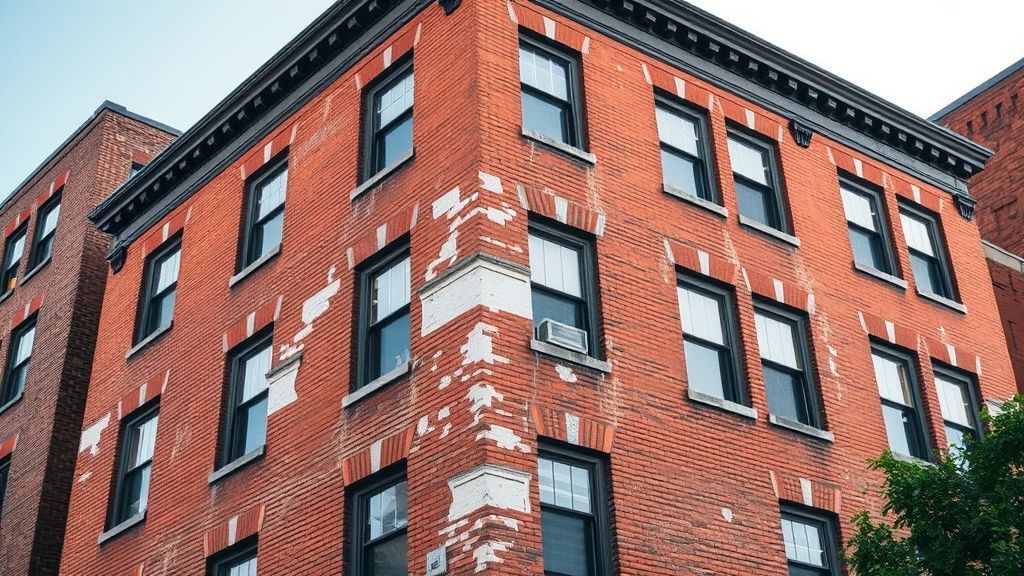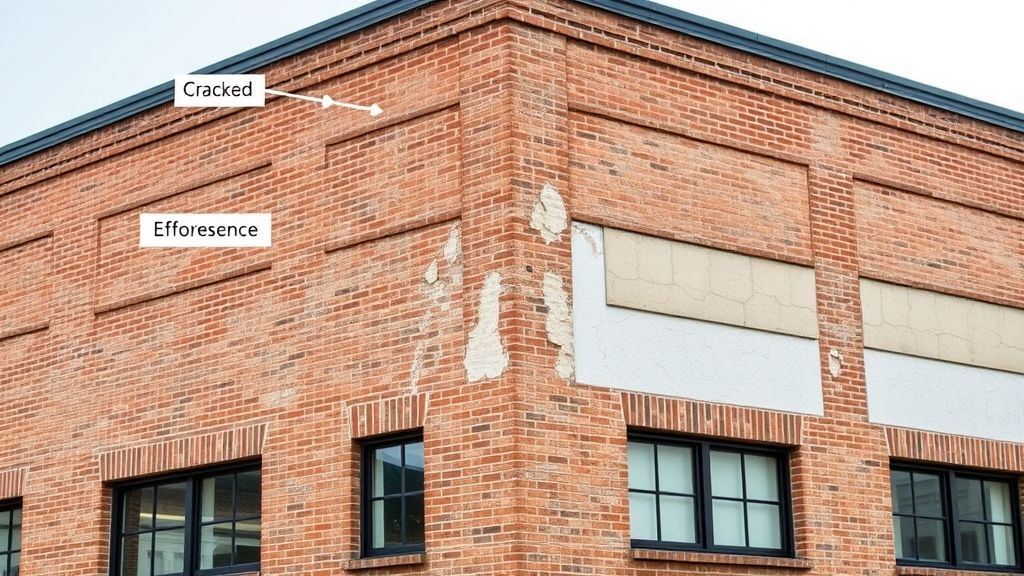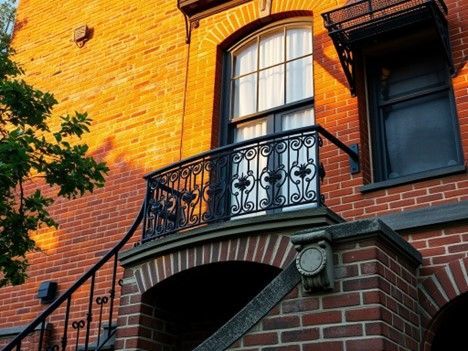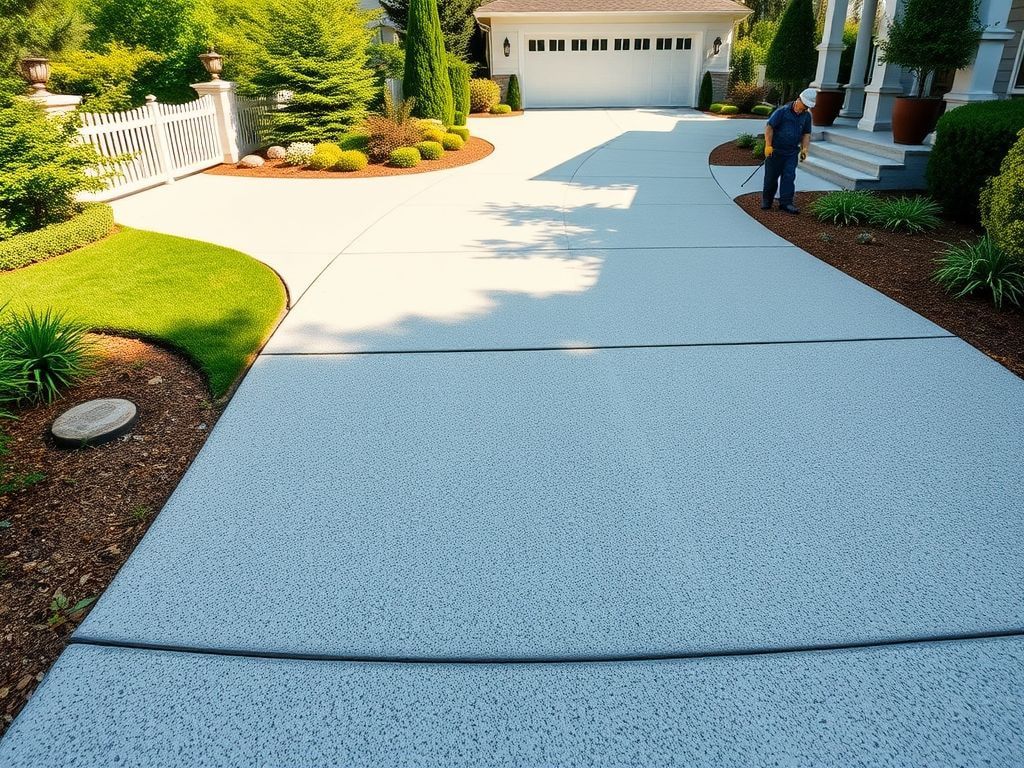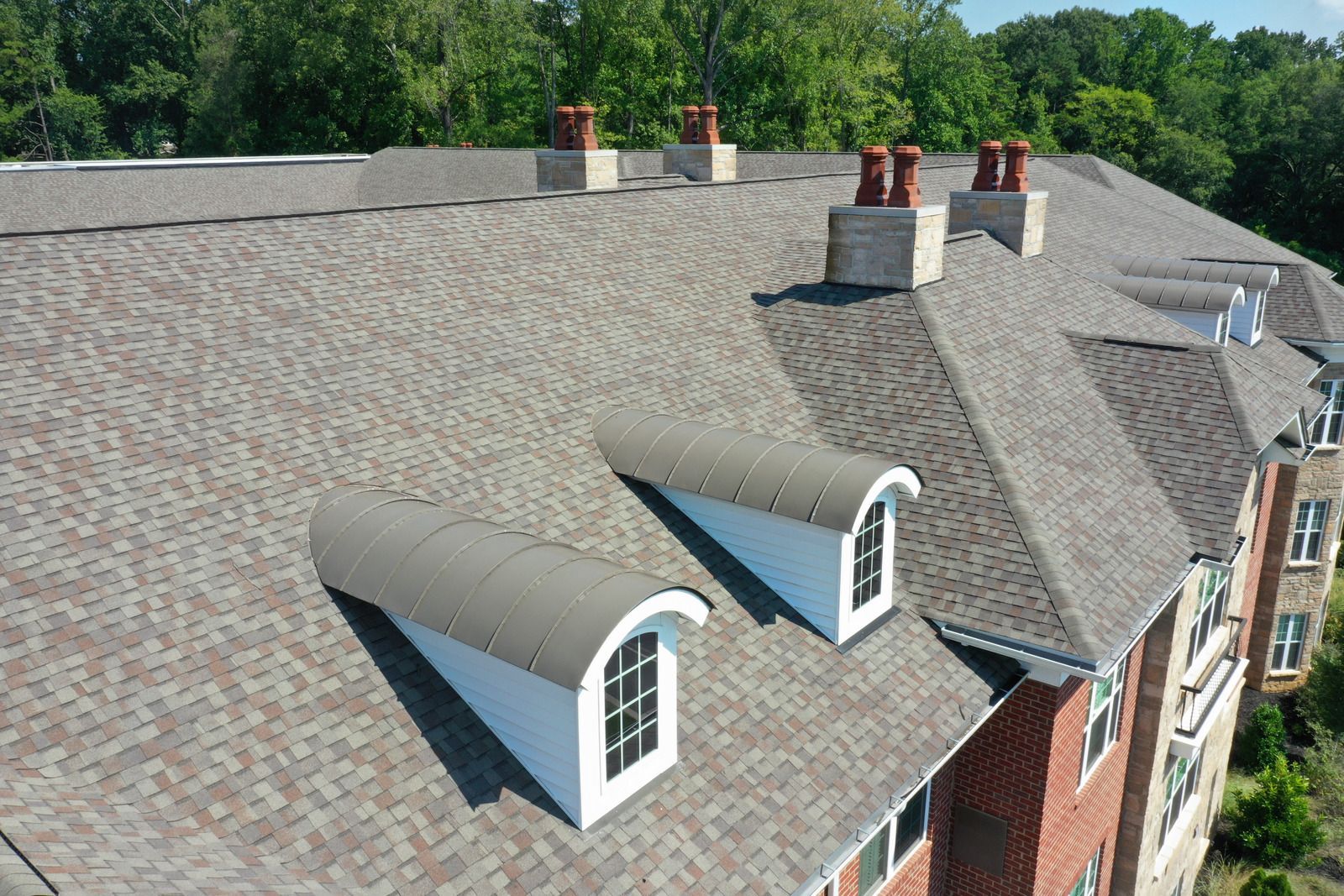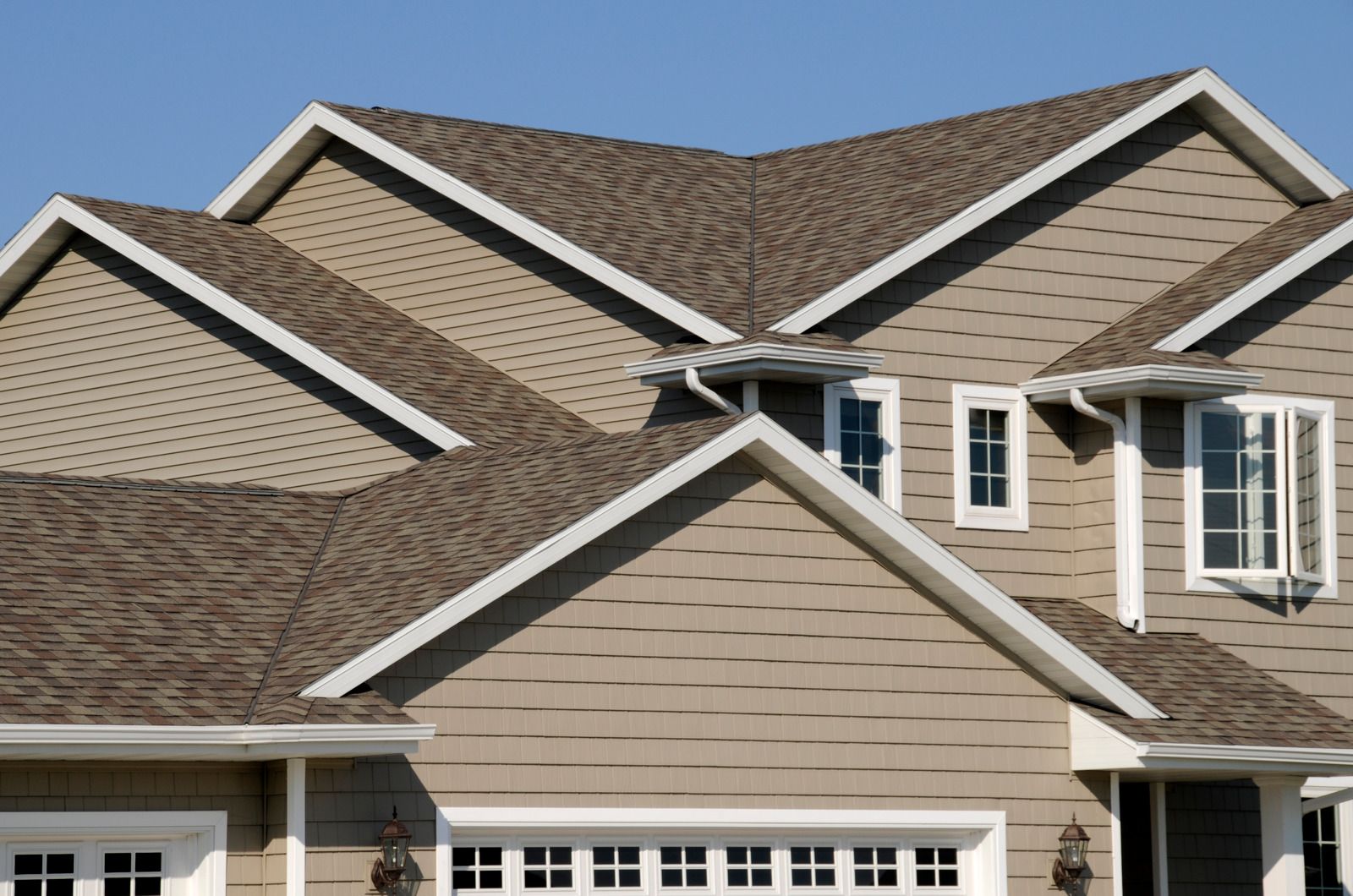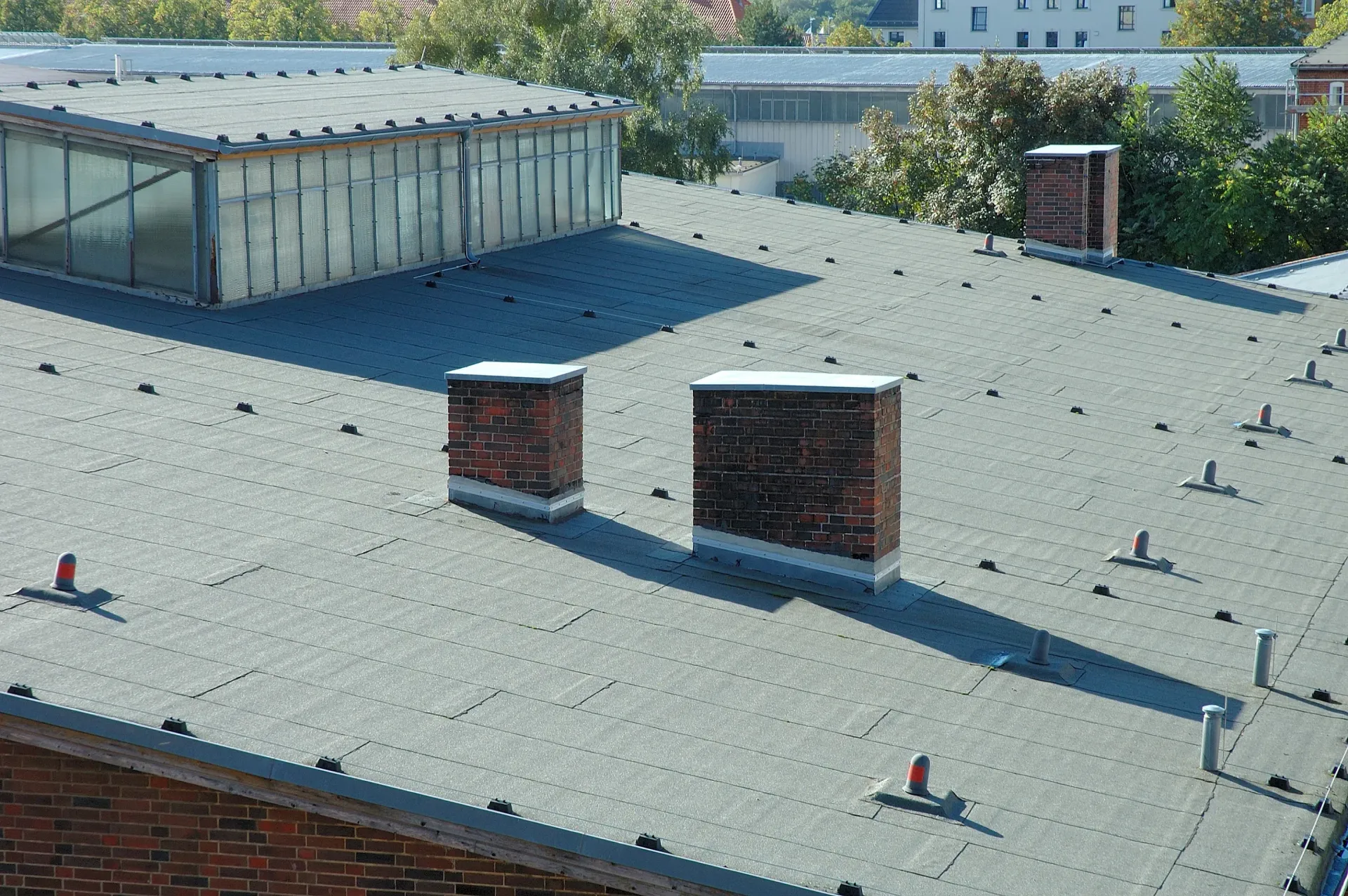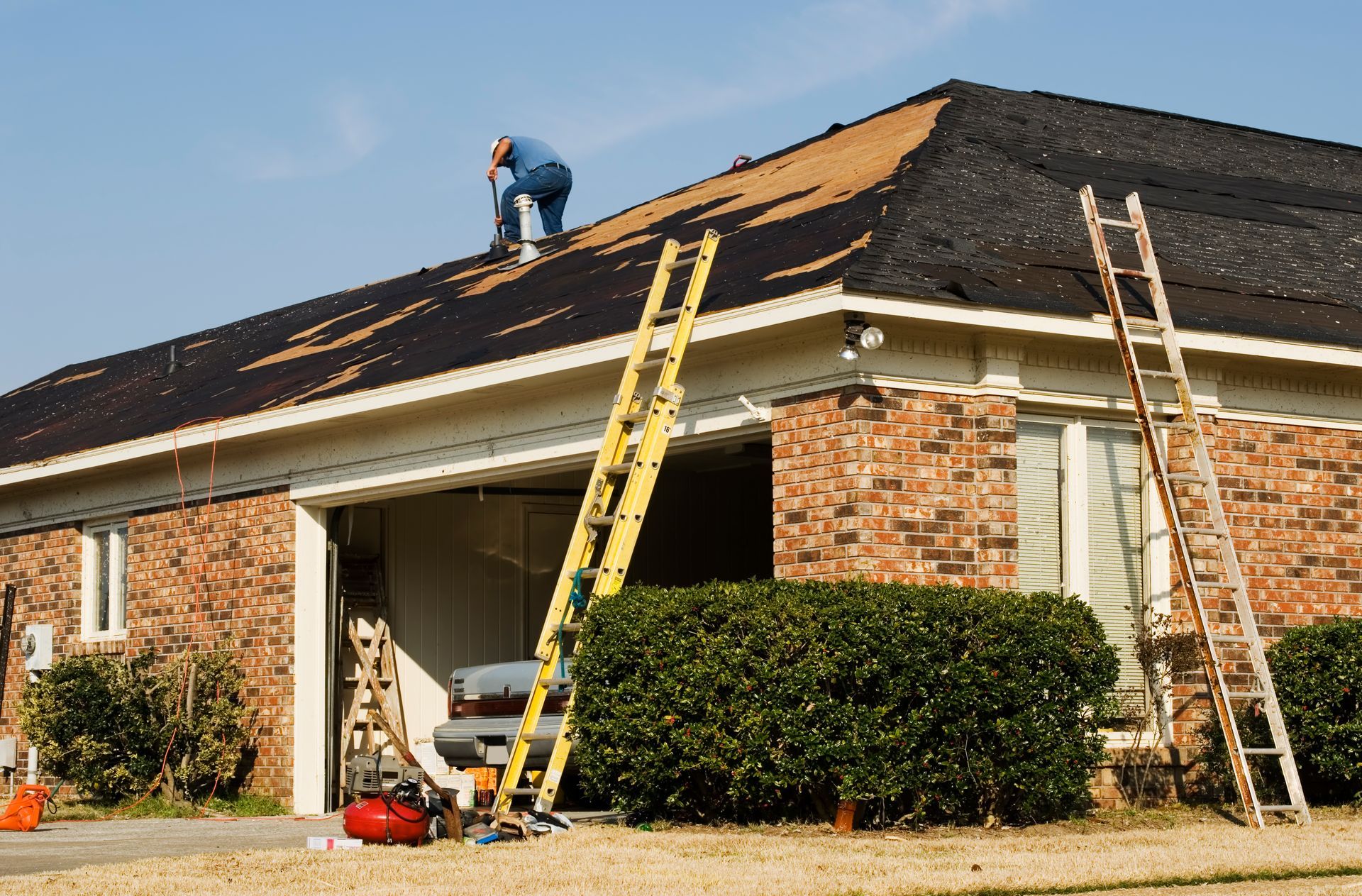The Property Manager's Roadmap to Evaluating Brick Pointing Quality and Condition
Article at a Glance:
- Brick pointing serves critical structural functions beyond aesthetics, including load transfer, water infiltration prevention, and protection of building interiors from moisture damage.
- Property managers should implement systematic inspection protocols with seasonal timing considerations to identify deterioration before it leads to significant structural problems.
- Early intervention on pointing issues is cost-effective, with repairs at moderate severity stages significantly reducing long-term restoration costs compared to waiting for severe deterioration.
- Different buildings require specific mortar types—historic structures typically need softer, lime-based mortars while modern buildings use harder Portland cement-based options.
- When evaluating contractor quality, look for consistent joint profiles, appropriate mortar characteristics, proper installation methodology, and comprehensive project specifications.
Long Island property managers who understand how to properly assess brick pointing condition can transform reactive maintenance into strategic property preservation, protecting building value while controlling long-term costs.
Whether managing a historic brownstone in Huntington or overseeing a commercial complex in Hempstead, your building's masonry directly impacts its longevity, value, and tenant satisfaction. Many property managers across Long Island face a common challenge: making critical decisions about masonry maintenance without specialized training.
Postponed brick pointing maintenance creates hidden costs that remain invisible until they manifest as serious structural problems. For Long Island properties, coastal salt exposure, harsh freeze-thaw cycles, and aging building stock accelerate deterioration. A small pointing deficiency today can become a major rehabilitation project next year—with significant budget implications.
This guide provides a systematic approach to evaluating brick pointing condition and quality. You'll gain practical tools to conduct meaningful assessments, recognize critical warning signs, and develop action plans that balance immediate needs with long-term property preservation.
Understanding Brick Pointing Fundamentals

The Structural Role of Pointing in Masonry Systems
Brick pointing refers to the exposed mortar joints between bricks or stones in a building's facade. While often viewed as merely cosmetic, pointing serves critical structural functions:
- Transfers structural loads between masonry units
- Prevents water infiltration into the building envelope
- Accommodates thermal movement and minor settlement
- Protects the building interior from moisture, drafts, and pests
From a business perspective, pointing represents your first line of defense against water damage—consistently among the most expensive maintenance issues property managers face. Water that penetrates deteriorated pointing damages more than just masonry; it potentially compromises interior finishes, insulation, and structural elements.
How Pointing Differs from Tuckpointing and Repointing
Understanding these distinctions helps you evaluate contractor proposals more effectively:
Pointing refers to the original mortar application between masonry units during construction.
Repointing involves removing deteriorated mortar to a specific depth and replacing it with new mortar—the most common restoration approach for compromised joints.
Tuckpointing is a specialized technique where two contrasting colors of mortar create the illusion of precise, thin joints, more common in historic preservation.
Pay attention to terminology when reviewing proposals. A contractor who uses these terms interchangeably may lack specialized knowledge needed for quality masonry work.
Common Mortar Types and Performance Characteristics
Mortar selection significantly impacts pointing performance and longevity. The right mortar must balance:
- Compatibility with existing materials
- Appropriate strength for structural needs
- Resilience against Long Island's climate challenges
Most historic buildings in Long Island used lime-based mortars, which remain softer and more flexible than modern Portland cement-based products. This softness isn't a flaw—it allows the masonry system to accommodate movement without cracking.
Modern buildings often use harder, Portland cement-dominant mortars. When evaluating a contractor's proposed mortar, watch for:
- Compatibility with existing masonry (inappropriate hardness can damage bricks)
- Ability to handle freeze-thaw cycles (critical for Long Island's coastal climate)
- Water permeance characteristics (mortar should allow the wall system to breathe)
- Appropriate compressive strength for the building's age and construction type
Industry Standard Mortar Types
For more specific guidance, familiarize yourself with standard mortar type designations:
Type K Mortar: Extremely soft with very high lime content. Primarily used for historic restoration of buildings constructed before 1900. Provides maximum flexibility but limited strength.
Type O Mortar: Moderately soft with high lime content. Commonly used for repointing historic buildings where some flexibility is needed but slightly more strength is required than Type K.
Type N Mortar: Medium strength, general-purpose mortar suitable for most above-grade exterior walls with normal loading. The most commonly specified type for modern construction.
Type S Mortar: Higher strength formulation used where additional structural capacity is required, such as below-grade applications or heavy load-bearing walls.
When repointing historic masonry, the general conservation principle is to use mortar that's softer than the original bricks. This ensures that any stresses are absorbed by the replaceable mortar rather than the historic bricks themselves. Using hard Portland cement-based mortars on soft historic brick can cause irreversible damage as the inflexible mortar forces the softer bricks to absorb movement and moisture, leading to spalling and cracking.
The Business Case for Proactive Pointing Maintenance
Before diving into inspection techniques, let's examine why pointing maintenance deserves priority in your property management strategy:
Cost Efficiency: Research in building envelope maintenance indicates that addressing pointing issues early can significantly reduce overall restoration costs compared to delaying until severe deterioration occurs. Early intervention also extends the functional lifespan of the masonry system.
Tenant Satisfaction: Well-maintained buildings command stronger tenant retention and higher values, particularly in premium markets where building aesthetics significantly impact marketability.
Risk Management: Property insurance specialists note that documented maintenance programs may positively impact insurance assessments. Properties demonstrating proactive maintenance planning often qualify for more favorable coverage terms.
Operational Impact: Coordinating pointing work with other envelope maintenance creates efficiency opportunities. Combining projects allows sharing of access costs (scaffolding, lifts) while reducing overall tenant disruption.
Energy Efficiency: Building performance studies show that deteriorated masonry joints create unintended air pathways that can impact heating and cooling efficiency. Maintaining proper brick pointing helps preserve the intended thermal performance of the building envelope.
The Critical Inspection Process
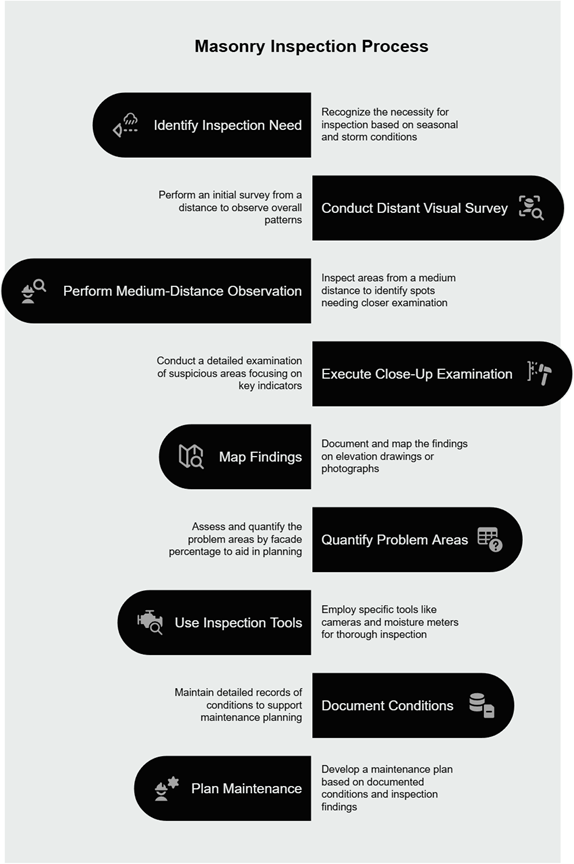
Systematic assessment creates the foundation for effective maintenance planning. A consistent inspection protocol helps identify problems early when intervention costs remain manageable.
Seasonal Timing Considerations for Masonry Inspections
The timing of your inspections significantly impacts what you'll discover. For Long Island properties, consider:
- Spring inspections (April-May): Evaluate winter damage from freeze-thaw cycles, especially on north and east-facing facades most exposed to winter storms.
- Fall inspections (September-October): Assess summer expansion damage and prepare for winter conditions, allowing time for emergency repairs before winter weather arrives.
- Post-storm checks: For coastal properties in areas like Long Beach or the Hamptons, consider additional assessments after major storms, as salt spray accelerates joint deterioration.
Schedule assessments well in advance of annual budget meetings to provide sufficient time for developing well-documented maintenance recommendations. The ideal timing depends on your organization's specific budget cycle and the property's unique needs.
Visual Assessment Methodology
A systematic approach ensures consistent evaluation across different properties and inspection cycles:
- Begin with a distant visual survey (from approximately 25-50 feet away), noting overall patterns of discoloration, efflorescence, or visible deterioration.
- Move to medium-distance observation (around 10-15 feet), identifying areas requiring closer inspection.
- Conduct close-up examination of suspicious areas, focusing on:
- Joint integrity (cracking, separation from brick edges)
- Mortar consistency (crumbling, powdering, softness)
- Water damage indicators (efflorescence, staining, biological growth)
- Previous repair quality and condition
- Map findings on elevation drawings or photographs to track deterioration patterns over time.
- Quantify problem areas by facade percentage to support budget planning.
Note: This methodology provides a foundational assessment. For significant concerns or when planning major restoration work, consultation with a professional mason or building envelope specialist is strongly recommended.
Consistent documentation tracking deterioration rates provides compelling evidence when justifying intervention timing to owners or boards.
Tools and Equipment for Thorough Pointing Evaluation
Effective assessment requires minimal but specific equipment:
- Digital camera with zoom capability (for documentation)
- Flashlight (for examining joint depth and shadowed areas)
- Small mirror on extendable handle (for inspecting recessed joints)
- Moisture meter (for identifying active water infiltration)
- Inspection probe or awl (for testing mortar hardness)
- Binoculars (for preliminary inspection of upper stories)
- Tablet or clipboard for real-time documentation
Investing in basic inspection tools pays significant dividends by reducing the need for expensive access methods during preliminary assessments. Thorough ground-level inspections often provide sufficient information for initial planning, reserving expensive access methods for verification and detailed scoping.
Documentation Best Practices for Condition Tracking
Effective documentation serves multiple business purposes:
- Creates defensible evidence for maintenance recommendations
- Provides baseline comparisons for deterioration rate assessment
- Supports capital planning and budget justifications
- Demonstrates due diligence in building maintenance
Consider these documentation approaches:
- Standard assessment forms with consistent rating scales
- Grid-based mapping of facades with condition coding
- Photo documentation with consistent angles and lighting
- Digital integration with property management software
- Year-over-year comparison protocols
Well-maintained records reduce institutional knowledge loss when transitioning properties between management companies or bringing new staff onto existing management teams.
Recognizing Quality Issues and Failure Indicators
The ability to distinguish between cosmetic concerns and structural threats separates reactive maintenance from strategic property management.
Early Warning Signs of Pointing Deterioration
Focus on issues requiring immediate attention versus those that can be monitored:
Priority concerns requiring prompt intervention:
- "Hollowness" when tapping on mortar joints (indicating separation)
- Vertical cracking that creates direct water paths into the wall system
- Efflorescence (white mineral deposits) indicating active water migration
- Spalling or deterioration of brick edges adjacent to mortar joints
- Soft, powdery mortar that can be easily scraped out with a key or coin
Issues warranting monitoring but not immediate action:
- Hairline cracks without displacement or water infiltration
- Minor erosion of joint face without deep penetration
- Superficial biological growth without joint deterioration
- Slight mortar color variation without structural compromise
Documenting these conditions with clear photographs and measurement creates compelling evidence when communicating with owners about necessary interventions.
Differentiating Between Surface and Structural Concerns
Not all pointing issues carry the same risk, and budget allocation should reflect this reality:
Surface-level issues typically affect appearance and early protection but don't immediately threaten structural integrity:
- Weathering of joint faces less than ¼" deep
- Superficial staining without material deterioration
- Hairline cracking without displacement
- Color inconsistencies from previous repairs
Structural concerns that warrant immediate attention:
- Joints eroded more than ½" deep
- Voids behind the outer mortar face (detected by hollow sound when tapped)
- Diagonal cracking patterns suggesting settlement or structural movement
- Bulging or displacement of masonry units
- Water infiltration evidenced by interior dampness
This distinction helps you prioritize repairs within constrained budgets, addressing structural threats first while potentially deferring cosmetic improvements.
Long Island-Specific Deterioration Patterns
The regional climate and building stock in Long Island create distinct challenges:
- Coastal properties face accelerated deterioration from salt spray, particularly on windward facades and upper stories
- Historic districts feature older lime-based mortars requiring specialized assessment approaches
- Buildings from the post-war development boom (1950s-1960s) often show systemic pointing failure as they reach 60-70 years of age
- Northern shore properties experience more intense freeze-thaw cycling than South Shore buildings
Properties maintaining consistent pointing quality generally experience better tenant retention and higher market values, particularly in premium markets where building aesthetics significantly impact marketability.
Quantifying Severity and Establishing Intervention Timeframes
Moving beyond subjective assessment to quantifiable metrics helps develop defensible maintenance schedules:
Low Severity (Monitor annually, intervention within 3-5 years):
- Less than 5% of joints showing superficial deterioration
- No active water infiltration
- Deterioration depth less than ¼"
- No brick damage adjacent to joints
Moderate Severity (Address within 1-2 years):
- 5-15% of joints showing noticeable deterioration
- Isolated areas of deeper erosion (¼" to ½")
- Minor efflorescence without significant brick damage
- Periodic minor water infiltration during heavy storms
High Severity (Immediate intervention required):
- More than 15% of joints deteriorated
- Consistent joint erosion exceeding ½" depth
- Widespread efflorescence or biological growth
- Brick damage progressing alongside joint failure
- Active water infiltration affecting interior spaces
Building envelope specialists and masonry restoration experts generally agree that interventions at the moderate severity stage can reduce overall restoration costs while extending the useful life of the masonry system.
Evaluating Contractor Workmanship
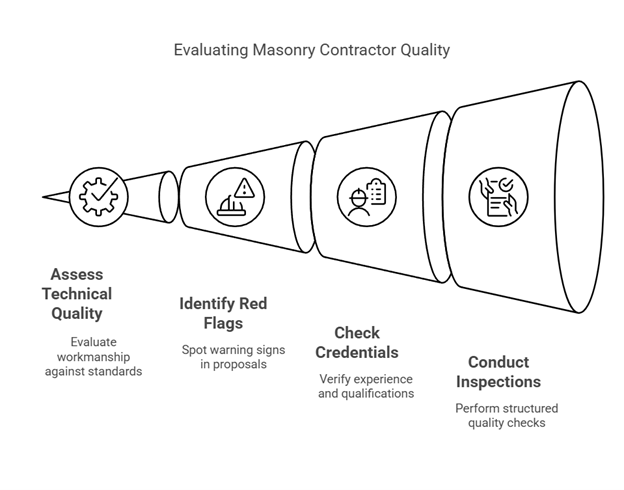
Finding qualified masonry contractors represents one of the most significant challenges for Long Island property managers. Developing objective quality assessment criteria helps separate skilled craftspeople from less qualified operators.
Technical Quality Markers in New Pointing Work
When inspecting completed pointing, evaluate these quality indicators:
Joint Tooling and Finishing:
- Consistent joint profile matching historic/existing conditions
- Clean, well-defined edges without smearing onto brick faces
- Uniform depth and compression across similar joint types
- Proper tooling timing (neither too wet nor too dry during finishing)
Mortar Characteristics:
- Color and texture consistency throughout the project
- Appropriate hardness for the building type and exposure conditions
- No visible shrinkage cracks within the new mortar
- Proper hydration evidenced by curing characteristics
Installation Methodology:
- Consistent joint depth (typically ¾" to 1" in repointing work)
- Complete filling of joints without voids or air pockets
- Clean interfaces between new mortar and masonry units
- Appropriate protection of adjacent surfaces and landscaping
Masonry industry professionals note that quality pointing work performed with appropriate materials and techniques should provide long-term service, while poor workmanship may fail prematurely—a significant consideration for your capital improvement planning.
Red Flags in Contractor Proposals and Specifications
When evaluating masonry contractor proposals, watch for these warning signals:
- Vague mortar specifications without detailed mix ratios
- Absence of joint preparation standards or minimum removal depths
- Unrealistically short timeframes that don't allow for proper curing
- Missing references to weather limitations and protection requirements
- One-size-fits-all approaches without consideration of building-specific needs
- Significantly lower pricing than other qualified bidders
- Lack of specific experience with similar building types in Long Island
Successful projects typically involve clear specifications regarding:
- Detailed mortar mix designs with specific proportions
- Minimum depth standards for removing deteriorated mortar
- Specific joint profiles appropriate to the building's architectural period
- Curing requirements including weather protection
- Clean-up and site management protocols
Construction management experts observe that comprehensive specifications lead to smoother project execution with fewer change orders and disputes compared to projects with vague scopes of work.
Credentials and Qualifications That Matter for Masonry Contractors
Unlike many construction trades, masonry restoration lacks standardized national certification. When selecting a contractor, prioritize these qualifications:
- Documented experience with similar buildings in Long Island
- Portfolio of completed pointing projects with similar scope
- Membership in industry organizations such as the International Masonry Institute
- References from other commercial property managers (not just residential clients)
- Knowledge of historic preservation standards when applicable
- Demonstrated understanding of Long Island's specific climate challenges
- Proper insurance coverage including pollution liability
The most valuable credential is often the contractor's demonstrated knowledge during preliminary discussions. Contractors who ask detailed questions about your building's history, previous repairs, and specific problem areas generally deliver superior results compared to those offering immediate generic solutions.
Inspection Protocols for Newly Completed Pointing Work
Implement a structured acceptance process to protect your property's interests:
- Scaffold or lift inspection before removal, examining work at close range under various lighting conditions
- Sample area evaluation at multiple locations across the facade, checking:
- Joint depth consistency
- Complete filling without voids
- Proper adhesion to masonry edges
- Consistent tooling and finish
- Clean brick faces without mortar smears
- Weather testing observation after initial curing, scheduling inspection during or immediately after rainfall to verify water shedding
- Documentation of completed work through detailed photography for future comparison
- Retention release only after full curing cycle and verification of performance
This structured protocol with specific hold points protects your investment and ensures accountability, addressing a common problem where quality issues often become apparent only after project completion and payment.
Translating Assessment into Action Plans
Moving from inspection findings to implementable plans requires balancing technical needs with business realities.
Developing Prioritized Maintenance Schedules Based on Conditions
Effective maintenance scheduling balances urgency with practical budget constraints:
Emergency Priorities (Address within 30-90 days):
- Active water infiltration affecting occupant spaces
- Safety hazards from loose masonry or severe deterioration
- Pointing failure threatening structural stability
- Conditions creating code violations or citation risks
Short-Term Priorities (Schedule within 6-12 months):
- Moderate deterioration on weather-exposed elevations
- Pointing issues causing accelerated brick deterioration
- Failed previous repairs requiring remediation
- Conditions that will likely worsen significantly over one seasonal cycle
Medium-Term Planning (1-3 year horizon):
- Early-stage deterioration without active water infiltration
- Minor deficiencies on less exposed elevations
- Preventive maintenance in vulnerable areas
- Aesthetic improvements to maintain property values
This prioritization framework helps allocate limited capital improvement funds based on risk assessment rather than reactive emergency spending.
Creating Compelling Recommendations for Owners and Boards
Translating technical assessment into approved projects requires strategic communication:
- Document deterioration visually with clear photographs, annotations, and comparison to industry standards
- Quantify financial implications of deferred maintenance, showing how preventive pointing work typically costs less than future brick replacement
- Present phased approaches that distribute costs across multiple budget cycles while addressing critical areas first
- Reference comparable properties where similar conditions led to significant failures and higher remediation costs
- Incorporate relevant regulatory requirements including municipality-specific facade inspection ordinances in places like Hempstead and North Hempstead
Successful property managers consistently secure maintenance approvals by focusing on long-term value protection rather than immediate cost concerns.
Budgeting Strategies for Phased Pointing Projects
Thoughtful budget planning for pointing work should consider:
Cost Efficiency Factors:
- Economies of scale from addressing multiple elevations simultaneously
- Seasonal timing considerations (planning during off-peak seasons may yield pricing advantages)
- Coordination with other envelope work to share access costs
- Preventive approaches targeting vulnerable areas before widespread failure
Financial Planning Approaches:
- Reserve allocations specifically for masonry maintenance
- Three-year rolling capital plans with annual reassessment
- Emergency contingency funds for unexpected failures
- Integration with broader building envelope maintenance planning
Building management professionals observe that properties with consistent masonry maintenance programs generally experience lower lifecycle costs compared to those operating in reactive emergency repair modes. This approach typically leads to more predictable cash flows and reduced operational disruptions.
Integrating Pointing Work with Other Envelope Maintenance
Strategic coordination addresses the excessive cost of multiple mobilizations for related building envelope work. Consider these integration opportunities:
- Coordinate pointing repairs with window replacement or caulking
- Integrate masonry work with gutter and downspout replacement
- Align pointing with waterproofing or parapet repairs
- Schedule pointing assessment before exterior painting projects
This integrated approach yields significant value through shared access costs (scaffolding or lifts), reduced administrative overhead, and minimized tenant disruption. Construction management specialists note that coordination between related building envelope projects typically creates efficiency gains compared to isolated projects with separate mobilizations.
Conclusion
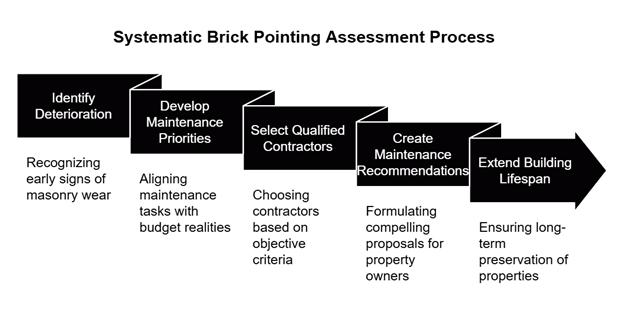
Effective brick pointing assessment represents far more than a technical exercise—it's a critical business function that directly impacts property values, operating costs, and tenant satisfaction. By implementing systematic evaluation processes, property managers can:
- Identify deterioration before it creates significant damage
- Develop data-driven maintenance priorities aligned with budget realities
- Select qualified contractors based on objective quality criteria
- Create compelling maintenance recommendations for owners and boards
- Extend building lifespans while controlling long-term costs
The key differentiator between reactive management and strategic property preservation lies in your ability to accurately evaluate masonry conditions, interpret their significance, and translate findings into actionable plans. This systematic approach not only protects the buildings under your care but enhances your professional credibility with owners, tenants, and other stakeholders.
Frequently Asked Questions
Q: How does brick pointing quality impact a building's energy efficiency and operating costs?
A: Deteriorated pointing creates pathways for energy loss. These microscopic channels allow air exchange between interior and exterior environments, affecting both heating and cooling efficiency. Additionally, moisture infiltration through compromised pointing can degrade insulation effectiveness. Properly maintained pointing helps preserve the thermal performance of masonry walls, which provide beneficial thermal mass that moderates temperature fluctuations. For Long Island properties, the combination of winter winds and summer humidity makes pointing integrity especially critical for maintaining indoor comfort and controlling utility costs.
Q: What are the most critical documentation practices for tracking pointing conditions across multiple properties?
A: Effective documentation includes standardized condition rating scales with consistent terminology across properties. A 1-5 rating system for each facade, supported by photographic documentation from consistent vantage points at each inspection cycle, works well. Digital platforms with geolocation capabilities allow precise tracking of specific problem areas over time. For larger management portfolios, developing benchmark comparisons across similar building types and ages helps identify patterns of accelerated deterioration that may warrant investigation of underlying causes rather than simple repairs.
Q: How should property managers balance historic preservation requirements with modern performance standards in older buildings?
A: This requires understanding both regulatory frameworks and performance priorities. For buildings in designated historic districts, engage with local preservation officials early in the planning process. Focus discussions on performance requirements alongside preservation goals. Many historic buildings in Long Island were constructed with softer, more permeable materials than modern standards might suggest, and these traditional specifications often perform better in historic structures than modern high-strength alternatives. Work with contractors who specifically understand these distinctions rather than general masonry companies with primarily new-construction experience.
Q: What are the liability implications for property managers who postpone necessary repointing work?
A: The liability exposure extends beyond simple property damage concerns. Property managers have fiduciary responsibilities to maintain buildings according to professional standards. Documented awareness of deterioration without appropriate action recommendations may constitute negligence, particularly if deterioration leads to safety incidents or significant property damage. The most protective approach combines thorough documentation, clear communication of findings to owners/boards, and explicit recommendations with timeframes and consequence explanations.
Q: How can pointing assessment be integrated into broader capital improvement planning cycles?
A: Incorporate pointing assessment into a comprehensive building envelope management program with coordinated timing of related systems. Establish baseline conditions for all envelope components using common rating scales and priority classifications. Develop rolling five-year capital plans that distribute masonry expenses strategically, addressing critical failures immediately while planning preventive work during appropriate seasons. Consider creating envelope reserve studies similar to mechanical system planning to transform unpredictable emergency expenses into manageable planned maintenance.
Frequently Unasked Questions
Q: How might climate change impact pointing deterioration rates and assessment intervals in Long Island properties?
A: Climate projections for Long Island suggest several shifts affecting masonry performance. Increasing storm intensity with driving rain will place greater stress on pointing integrity. Rising sea levels combined with storm surge will expand salt spray exposure to buildings previously outside the coastal zone. The changing freeze-thaw cycle pattern creates new stresses in masonry systems, potentially requiring adjustment to traditional assessment intervals. Properties in coastal areas should consider implementing more frequent inspection protocols specifically evaluating salt exposure effects.
Q: What are the organizational implications of developing in-house pointing assessment expertise versus relying on external consultants?
A: In-house expertise development requires initial investment but typically yields better long-term oversight and consistent assessment, working well for firms managing large portfolios of similar buildings. External consultants bring specialized knowledge and comparative experience across many properties but at premium costs. The key issue is long-term knowledge retention, as property management firms with high staff turnover often lose significant institutional knowledge about building conditions and previous interventions. Many firms adopt hybrid models: developing basic assessment capabilities in-house while engaging specialized consultants for periodic comprehensive evaluations.
Q: How does pointing condition assessment differ between various building types and construction eras common in Long Island?
A: Pre-1900 buildings typically feature solid masonry construction with lime-based mortars, requiring assessment focused on moisture management rather than just structural stability. Post-war commercial structures often employed cavity wall construction with harder mortars, requiring particular attention to expansion joint integrity and flashings. Contemporary buildings frequently utilize masonry as a veneer rather than structural element, so assessment must focus on anchor systems, support shelves, and the relationship between pointing and other envelope components. Adapting assessment protocols to match specific building technologies achieves more accurate intervention timing and more effective repair strategies.
Q: What technological innovations are changing traditional pointing assessment methodologies?
A: Infrared thermography enables rapid non-invasive assessment of moisture patterns within masonry walls. Drone-based visual inspection with high-resolution imaging allows close examination of difficult-access areas without expensive scaffolding. Software systems that create three-dimensional facade models permit dimensional analysis and deterioration mapping with unprecedented precision. Predictive analytics platforms combining weather data, construction details, and historical performance generate deterioration forecasts that help optimize inspection timing and intervention planning.
Extend the Life of Your Building with Professional Brick Pointing
Don't wait until minor mortar issues turn into costly structural problems. At City Suburb Inc., we specialize in high-quality brick pointing to enhance energy efficiency, prevent pest intrusion, and improve fire resistance—ensuring your property remains safe, durable, and visually appealing.
Serving Queens, Brooklyn, Long Island, the Bronx, Manhattan, and surrounding areas, our skilled masonry team provides expert solutions tailored to your building’s unique needs.
📞 Take the next step toward long-term property preservation—reach out to us today!
👉 Browse our website to learn more about our services.
👉 Follow us on
Facebook and
Instagram for expert tips and project updates!
